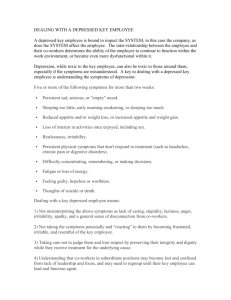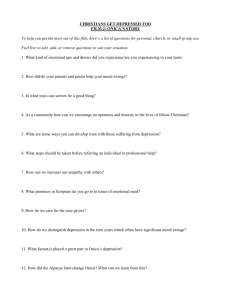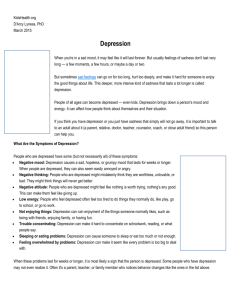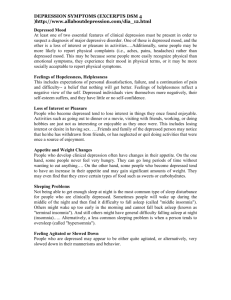final lecture 2
advertisement
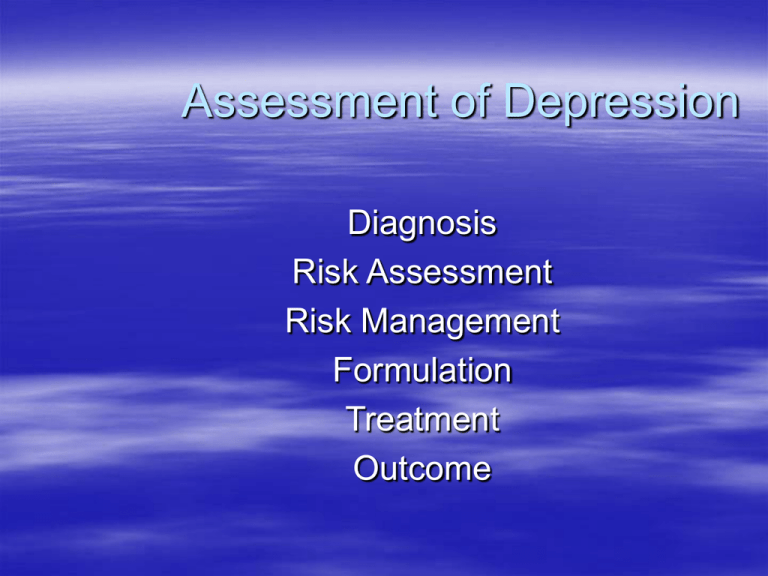
Assessment of Depression Diagnosis Risk Assessment Risk Management Formulation Treatment Outcome Associated symptoms in increasing importance: Insomnia Fatigue loss of interest/pleasure Morbid self-opinion Impaired concentration Hopelessness ± suicidal thoughts. (Blacker and Clare ‘88) Diagnostic domains Affective symptoms Physical symptoms Cognitive symptoms Affective Diagnostic Criteria. Must haves! Depressed mood (irritable in children or adolescents). Or markedly diminished interest or pleasure Must be most of the time over at least 2 weeks. Change from normal functioning Physical symptoms Weight change when not dieting Sleep disturbance –insomnia (particularly middle insomnia and EMW), hypersomnia. Agitation or retardation Fatigue/loss of energy Cognitive symptoms Worthlessness, xs/inappropriate guilt Diminished ability to think and concentrate Recurrent thoughts of death and suicide Diagnosis Eye contact - observe body language. Open questions. Attend to “distinct quality of mood” eg.Coldness/deadness/emptiness. Paykel ’85 Comorbidity and missed diagnosis Presentation affected byGender (Women 2:1 Men) Age Insight Comorbid physical illness Gotland survey. Pop 56,000 60% GPs trained in depression diagnosis 1981/2 By 1985 - ↓ referrals 50%, inpatient by 75% and sick leave by 50% Suicide rates dropped from 20 to 7/100,000 Antidepressant prescribing increased 60% Anxiolytic prescribing decreased 25% Suicides ♀:♂ ratio 2:3 before the programme 1:7 after. Of increased px 1/3 ♂, 2/3 ♀ Of increased ♂ px most were for elderly! Improved ability in Primary Care benefits those in contact with Primary Care i.e. Women! Male Depressive Syndrome Lowered stress tolerance Acting out/aggression/low impulse control/ Transitional sociopathy Burnt out feeling/emptiness Chronic fatigue Irritability/restlessness/dissatisfaction Indecision Sleep disturbance/morning anxiety Missed depression Depressed mood may be absent Watch for “inner emptiness or deadness” Prominent anhedonia Somatic complaints in patients with poor verbal skills or the elderly Pseudo dementia- behavioural withdrawal, memory problems Unexplained physical symptoms associated with depression e.g. pain . Impt to rule out organic cause Depression – the physical presentation In primary care, physical symptoms are often the chief complaint in depressed patients In a New England Journal of Medicine study, 69% of diagnosed depressed patients reported unexplained physical symptoms as their chief complaint1 N = 1146 Primary care patients with major depression Reference: 1. Simon GE, et al. N Engl J Med. 1999;341(18):1329-1335. Is your depressed patient bipolar? Co morbid substance abuse Bipolar family history * Seasonality Early onset <25 yrs * Postpartum onset * Psychotic features <35 yrs */ Atypical features Rapid on/off pattern, frequent recurrence, < 3mth duration * /Mixed affective state ** Antidepressant mania/hypomania ** Ask about symptoms of hypomania just preceding or following depression either 1st episode or early-onset depression Prevalence of Bipolar Spectrum subtype 26-39% depressed patients in Primary Care 45% depressed outpatients Allilaire et al “EPIDEP Trial”. Encephale 2001;27:149-158 Risk Assessment Risk - aggression to self , others & property - substance misuse - vulnerability/ exploitation Ask direct questions about suicide – “have you thought about or are you thinking about hurting or killing yourself” If yes or unsure, enquire about plan. If yes but wouldn't do it then “What is stopping you from doing something?" (protective factors) Predictors of Risk S – lack of significant others, stress events. U – unsuccessful attempts, unemployment, unexplained improvement. I – identification with family history/peer group suicide. CI – chronic illness or severe illness of recent onset Predictors of Risk 2 D – depression + hostility/hopelessness or frustration, decision that suicide is an option A – age, alcohol, availability. L – lethality of previous attempts e.g. guns, hanging, jumping BEHAVIOURAL THEORY Stimulus-Response-Reward-Repetition Risk Assessment Risk Management – current and FUTURE Therapeutic Risk/ Responsiblity PRESCRIPTIVE DISASTER DISclosure Anxiety. narrowed choiceS Taking responsibility. PatiEnt out of control. Referral to other. Interview Style Be Perceptive- listen and understand, take distress seriously do not dismiss, minimise or ignore- build rapport. Be Peaceful and calm. Do not appear threatened. Partnership approach- they share responsibility for choosing the treatment approach. Empowerment reduces helplessness reduces risk! Interview Style 2 Be Persuasive- discuss the thoughts/plans in a reasoned manner- “these are symptoms of a treatable condition, they are very common and are often temporary. Be Positive – instillation of HOPE is the most protective thing you can do. Collaborative risk management Disclosure. Further enquiry. Normalisation Informed choices. Agreed plan. Consequences of risk management Patient retains responsibility Patient understood and in control. Self image stronger. Risk lower in subsequent stress What is Case Formulation? “Case formulation aims to describe a person’s presenting problems and use theory to make explanatory inferences about causes and maintaining factors that can inform interventions” Kuyken 2006 Case formulation 2 Predisposing factors Precipitating factors Protective factors Perpetuating factors Hypothesis –Inferred mechanisms- goals Exercise Examples TREATMENT Keep taking the tablets!! – Effective drug & dose Psychological – counselling, CBT, psychodynamic psychotherapy Social- don’t forget these interventions; common sense and can make a lot of difference! Outcome – response v remission Aim for remission “are you back to your normal self?” Use outcome measure GAF/Honos


